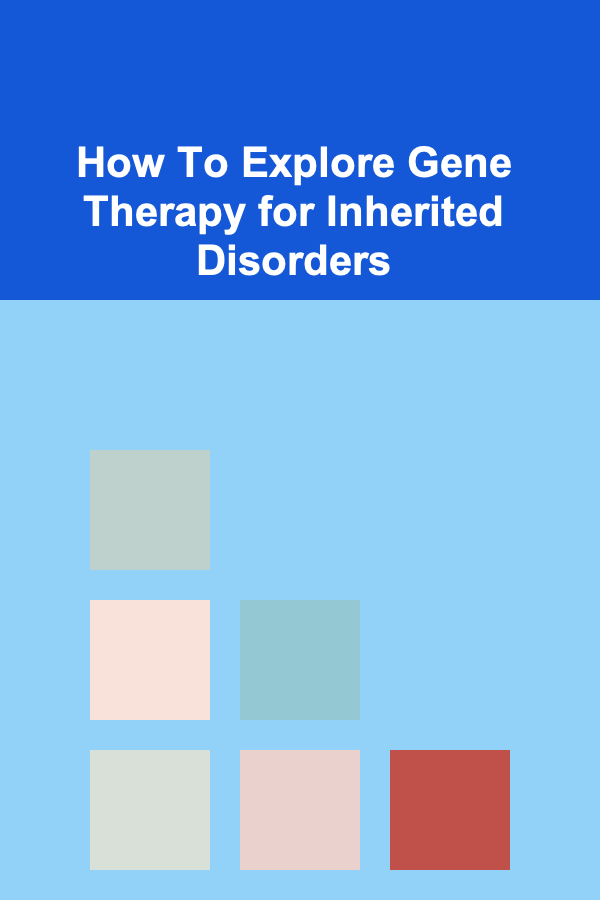
How To Explore Gene Therapy for Inherited Disorders
ebook include PDF & Audio bundle (Micro Guide)
$12.99$9.99
Limited Time Offer! Order within the next:

Gene therapy is one of the most exciting frontiers in modern medicine, offering the potential to treat or even cure a variety of inherited disorders that were once considered untreatable. Inherited disorders, often caused by mutations in a single gene, can lead to debilitating conditions and premature death. Traditional treatments focus on managing symptoms, but gene therapy offers the possibility of addressing the root cause of these disorders by altering the genetic material of an individual.
This article will explore how to explore gene therapy for inherited disorders, focusing on the mechanisms of gene therapy, its potential for treating inherited diseases, current advancements, ethical considerations, challenges, and the future prospects of this groundbreaking approach.
Understanding Gene Therapy
Gene therapy involves the introduction, removal, or alteration of genetic material within a patient's cells to treat or prevent disease. It is often used in the context of inherited disorders, where the underlying cause of the disease is a genetic mutation. By altering or replacing the faulty gene, gene therapy aims to correct the genetic defect and restore normal function.
There are several types of gene therapy techniques, including:
1.1. Gene Addition
This is the simplest form of gene therapy, where a healthy copy of a gene is introduced into the patient's cells. The goal is to provide a functioning version of the gene to replace the defective one. This technique is often used for disorders caused by a missing or malfunctioning gene.
1.2. Gene Editing
Gene editing involves directly modifying the patient's genetic material. Techniques like CRISPR-Cas9 allow scientists to make precise changes to the DNA sequence, either by correcting mutations or by inserting new genes into specific locations in the genome. Gene editing offers more targeted interventions and is a powerful tool for treating inherited disorders.
1.3. Gene Silencing
In some cases, an inherited disorder may be caused by a gene that is producing harmful proteins. Gene silencing techniques aim to "turn off" the expression of this gene, preventing the production of the harmful protein. One of the most well-known methods for gene silencing is RNA interference (RNAi).
Inherited Disorders and Their Genetic Basis
Inherited disorders are caused by genetic mutations passed down from one generation to the next. These disorders can be classified into several categories based on the type of genetic inheritance involved:
2.1. Autosomal Dominant Disorders
Autosomal dominant disorders occur when a mutation in one copy of a gene is enough to cause the disorder. Individuals with these disorders have a 50% chance of passing the mutated gene on to their offspring. Examples of autosomal dominant disorders include Huntington's disease, Marfan syndrome, and achondroplasia.
2.2. Autosomal Recessive Disorders
Autosomal recessive disorders occur when an individual inherits two copies of a mutated gene---one from each parent. These disorders are typically more severe and may not manifest until later in life. Examples of autosomal recessive disorders include cystic fibrosis, sickle cell anemia, and Tay-Sachs disease.
2.3. X-Linked Disorders
X-linked disorders are caused by mutations in genes located on the X chromosome. These disorders predominantly affect males, as they have only one X chromosome. Females, with two X chromosomes, are less likely to develop the condition but can be carriers. Hemophilia and Duchenne muscular dystrophy are examples of X-linked disorders.
2.4. Mitochondrial Disorders
Mitochondrial disorders are caused by mutations in the DNA of mitochondria, the energy-producing organelles within cells. These disorders are passed down from mother to child, as only the mother's mitochondria are inherited. Leber's hereditary optic neuropathy and mitochondrial myopathy are examples of mitochondrial disorders.
Understanding the genetic basis of these inherited disorders is crucial in designing gene therapies. By identifying the specific mutation responsible for a disorder, scientists can develop targeted treatments that address the underlying cause.
Mechanisms of Gene Therapy for Inherited Disorders
Gene therapy can be used to treat a variety of inherited disorders by manipulating the genetic material within the patient's cells. The goal is to restore normal gene function, either by replacing defective genes or by modifying the existing genes. There are several key mechanisms through which gene therapy can be applied:
3.1. Gene Replacement Therapy
Gene replacement therapy is based on the idea of introducing a functional copy of a gene into the patient's cells. This is particularly useful for disorders caused by the absence or dysfunction of a specific gene. For example, in cases of cystic fibrosis, a defective CFTR gene causes the disease. Replacing the faulty gene with a healthy version can restore normal function.
Gene replacement therapy typically involves the use of vectors---vehicles that carry the gene into the patient's cells. These vectors are often modified viruses that are safe and capable of delivering genetic material into the cells. Adenoviruses, lentiviruses, and adeno-associated viruses (AAVs) are common vectors used in gene therapy.
3.2. Gene Editing with CRISPR-Cas9
Gene editing technologies, particularly CRISPR-Cas9, have revolutionized gene therapy. CRISPR allows scientists to make precise alterations to the DNA at specific locations. By using a "guide RNA" to direct the Cas9 protein to the target area, the gene can be cut and either repaired or replaced.
This approach has significant potential for treating inherited disorders caused by single-gene mutations. For example, sickle cell anemia, caused by a mutation in the hemoglobin gene, could potentially be treated by correcting the mutation with CRISPR. The ability to directly edit genes offers great promise in curing genetic diseases at their source.
3.3. Gene Silencing with RNAi
Gene silencing is another strategy used in gene therapy. In some inherited disorders, a defective gene produces harmful proteins that contribute to disease. RNA interference (RNAi) can be used to "turn off" the expression of these harmful genes. By targeting the messenger RNA (mRNA) that carries the instructions for making the protein, RNAi can prevent the production of the toxic protein.
One example of gene silencing is in the treatment of Huntington's disease, where the mutated huntingtin gene produces a toxic protein. By using RNAi to reduce the expression of the mutant gene, it may be possible to prevent the progression of the disease.
3.4. Ex Vivo and In Vivo Gene Therapy
Gene therapy can be categorized as either ex vivo or in vivo, depending on where the genetic modifications take place:
- Ex Vivo Gene Therapy: In ex vivo gene therapy, cells are taken from the patient, genetically modified in the laboratory, and then reintroduced into the patient's body. This technique is commonly used for blood disorders, such as sickle cell anemia and beta-thalassemia, where hematopoietic stem cells are modified to produce healthy blood cells.
- In Vivo Gene Therapy: In vivo gene therapy involves delivering genetic material directly into the patient's body. This approach is used for disorders that affect tissues or organs that are difficult to reach with ex vivo methods, such as retinal diseases or certain neurological disorders.
Current Advancements in Gene Therapy
Gene therapy has made tremendous progress in recent years, and several treatments have been developed and approved for clinical use. Some of the most notable advancements include:
4.1. Luxturna for Retinal Diseases
Luxturna is the first FDA-approved gene therapy for a retinal disease, specifically for inherited retinal dystrophy caused by mutations in the RPE65 gene. This therapy involves delivering a healthy copy of the RPE65 gene directly to the retina using an adeno-associated virus vector. The treatment has shown promising results in restoring vision in patients with this rare genetic disorder.
4.2. Zolgensma for Spinal Muscular Atrophy
Zolgensma is a groundbreaking gene therapy for spinal muscular atrophy (SMA), a severe neurodegenerative disorder caused by a mutation in the SMN1 gene. Zolgensma uses a viral vector to deliver a functional copy of the SMN1 gene to the patient's cells. This therapy has shown remarkable success in improving motor function and survival in infants diagnosed with SMA.
4.3. CAR T-Cell Therapy for Cancer
While not specifically an inherited disorder, CAR T-cell therapy represents an innovative gene therapy approach that involves modifying a patient's own T-cells to target cancer cells. This therapy has demonstrated significant success in treating certain types of blood cancers, such as leukemia and lymphoma, by reprogramming the immune system to fight cancer more effectively.
These advancements highlight the potential of gene therapy to treat a wide range of genetic disorders and open the door for further developments in the field.
Ethical Considerations and Challenges
While gene therapy holds great promise, it also raises several ethical and practical concerns that must be addressed:
5.1. Germline vs. Somatic Gene Therapy
Germline gene therapy involves modifying the genes in a person's reproductive cells (eggs or sperm) or early embryos, leading to permanent changes that are passed down to future generations. While this approach has the potential to eliminate inherited diseases from a family line, it also raises ethical concerns about unintended consequences and the possibility of "designer babies."
Somatic gene therapy, on the other hand, involves modifying the genes in somatic (non-reproductive) cells, which affects only the individual receiving the treatment and does not pass on the changes to future generations. Somatic gene therapy is generally considered more ethically acceptable, but it also presents challenges in terms of safety, delivery, and long-term effectiveness.
5.2. Access and Equity
As gene therapies become more advanced, access to these treatments will become a critical issue. Gene therapies are often expensive, and not all patients will have equal access to these potentially life-saving treatments. Efforts must be made to ensure that gene therapy is available to all patients, regardless of their socioeconomic status.
5.3. Long-Term Safety and Efficacy
Although gene therapy has shown great promise in clinical trials, its long-term safety and efficacy are still being evaluated. There is concern about potential off-target effects, where unintended genes may be altered, or the possibility of an immune response against the introduced genes. Rigorous clinical trials and long-term monitoring are essential to assess the safety of these treatments.
The Future of Gene Therapy
The future of gene therapy for inherited disorders looks bright, with new techniques and discoveries continuously improving the field. In the coming years, we can expect to see:
- More Gene Therapies for Rare Genetic Disorders: As our understanding of genetic diseases improves, we will likely see more gene therapies developed for rare inherited disorders.
- Advancements in Gene Editing Technologies: CRISPR and other gene editing tools will continue to evolve, making it easier and more precise to correct genetic mutations.
- Personalized Gene Therapy: Advances in genomics and biotechnology will allow for more personalized gene therapy approaches, tailoring treatments to the individual patient's genetic profile.
With continued research, collaboration, and ethical considerations, gene therapy has the potential to transform the treatment of inherited disorders, offering hope to millions of people affected by these debilitating conditions.
Conclusion
Gene therapy represents a revolutionary approach to treating inherited disorders by addressing the genetic causes of these diseases. With advancements in gene editing, gene replacement, and gene silencing techniques, the possibilities for treating previously untreatable genetic conditions are expanding. However, challenges remain, particularly around safety, accessibility, and ethical concerns.
As we continue to explore the potential of gene therapy, it is clear that this field holds enormous promise for improving the lives of individuals with inherited disorders, offering hope for cures and better treatment options in the future.
Reading More From Our Other Websites
- [Home Party Planning 101] How to Add Personal Touches to Your Home Party Decor
- [Personal Care Tips 101] How to Get the Best Results from Your Antiperspirant Application
- [Home Security 101] How to Communicate Security Plans with Your Family
- [Personal Care Tips 101] How to Use Body Butter to Treat Dry Skin on Your Neck and Décolletage
- [Home Staging 101] How to Stage a Home for First-Time Homebuyers
- [Metal Stamping Tip 101] Best Safety Protocols for Operators Working with High‑Force Metal Stamping Equipment
- [Organization Tip 101] How to Organize Recipes with Visual Inspiration Boards
- [Organization Tip 101] The Best Deck Staining Products for a Long-Lasting Finish
- [Organization Tip 101] Essential Tools for Installing Crown Molding in Your Home
- [Ziplining Tip 101] Beyond the Rope: How Ziplining Fuels Creative Inspiration and Mental Wellness

How to Keep Your Travel Gear Clean and Organized
Read More
How to Organize Vintage Finds by Functionality
Read More
How to Save Money on Home Furnishings During Holiday Sales
Read More
How To Warm Up Your Voice Before a Speech
Read More
10 Tips for Content Planning with Limited Resources
Read More
10 Tips for Overcoming Writer's Block in Poetry
Read MoreOther Products

How to Keep Your Travel Gear Clean and Organized
Read More
How to Organize Vintage Finds by Functionality
Read More
How to Save Money on Home Furnishings During Holiday Sales
Read More
How To Warm Up Your Voice Before a Speech
Read More
10 Tips for Content Planning with Limited Resources
Read More